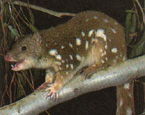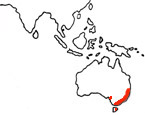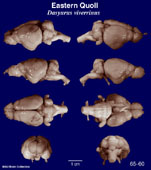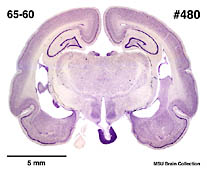|
Eastern
Quoll
(Dasyurus viverrinus) #65-60 |
||||
|
|
Physical
characteristics and distribution
|
|
Head and body length is 350-450 mm, tail 210-300. Coloration varies from mostly gray, olive brown or dark rufous brown on top, with a less common black phase. This occurs in both sexes, and in litters with more commonly colored individuals. All color phases have prominent white spots on the back and sides. The coat is generally short, thick and soft. Dasyurus viverrinus is unique in the genus in that the first toe on the hind foot is lacking. The foot pads are granulate. The pouch is shallow, formed by a patch of skin which covers the six to eight mammae. Dasyurus viverrinus prefers dry forest and open country and is primarily terrestrial, though it is a good climber. They are also mostly nocturnal, though they have been seen by day. The
main commponent of its diet is invertebrates, especially agricultural
pests such as the cockchafer beetle and corbie grub. Carrion
and some fruits are also eaten. |
|
Description
of the brain
|
|
The brain weight is 7.26 g (includes R. Trg. & C2 DRG Vom-Nas.). The brain meaurements are: Length AP left 22.4 mm; Length AP right 22.7 mm; Bitemporal width 24.3 mm; Temporal height left 19.5 mm; Temporal height right 19.1 mm. |
|
Animal
source and preparation
|
|
All
specimens collected followed the same preparation
and histological procedure.
|
Other Related Resources (websites and publications)
List of Specimens | Explore Collections | Brain Sections | Brain Evolution | Brain Development | Brain Circuitry | Brain Functions | Location and Use | Related Web Sites | Contact Us | Search MSU Database | Personnel | Home



